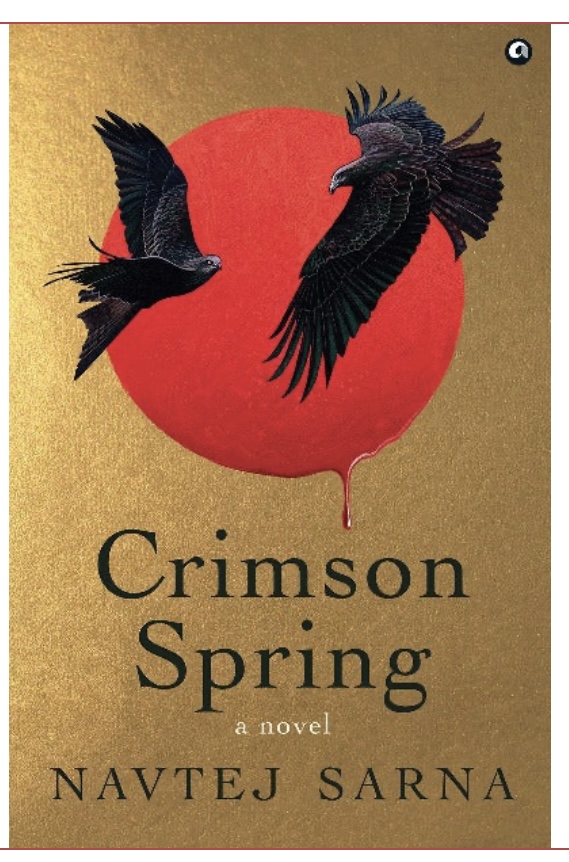In the deftly woven imagery, the author paints with potent words the horrifying atrocity that unleashed in the Jallianwalla Bagh more than a hundred years ago.
by Lily Swarn
On April 13, 1919, around twenty five thousand unarmed Indians had gathered in Jallianwalla Bagh, Amritsar. There were several children amidst the crowd listening to speakers denounce the inequities of the Rowlatt Act, which had been imposed on the country by the British. Many of them were relaxing and catching up with friends. Brigadier General R.E.H. Dyer entered the Bagh with a detachment of soldiers a bit after 5 in the evening. Without warning the crowd to disperse, Dyer ordered his troops to open fire. Hundreds died and hundreds more were injured as, at least, 1650 rounds were fired.
In his latest book, set against the epic backdrop of India’s freedom struggle, World War – I and the Ghadar Movement, former diplomat and author Navtej Sarna has vividly brought alive the brutal killing of the ill-fated humans.
Sporting a sky blue turban, Sarna was in Chandigarh’s UT Guest House for the release of Crimson Spring. Having served multiple diplomatic assignments for India – Ambassador to the United States and Israel, High Commissioner to the UK, Secretary, Government of India and Foreign Office Spokesperson – Sarna’s illustrious literary works include two novels: The Exile and We Weren’t Lovers Like That. This in addition to his works of non-fiction and voluminous translations.
In the deftly woven Crimson Spring, Sarna paints with potent words the horrifying atrocity that unleashed in the Jallianwalla Bagh over a hundred years ago. The book begins by a quote from I L Peretz: “A people’s memory is history; and as a man without memory, so a people without a history cannot grow wiser, better.”
The author has created nine life-like characters in this historical fiction – ordinary people, powerful officials, the guilty and the innocent, Indians and Britons. That day their lives changed forever. Crimson Spring is a book that won’t leave a reader unshaken or unmoved .The characters of Gurnam Singh Gambhir and Maya Devi are inspired by real life people who gave testimony to the Congress committee.
Maya Devi is based on Rattan Devi who spent the night in the Bagh warding off dogs with a stick. Her account is enough to shake up any one.
At the book release, Sarna mentioned that he relied a lot on the Hunter Committee and the Congress Punjab Enquiry. Perhaps that’s why these characters seem very believable as does that of Kirpal Singh. Their stories are lovingly sketched and one is moved by an urge to read the transcripts that helped create these characters .The character of Sergeant Nicholas Williams Is based on Williams J.Anderson , Dyer’s personal Bodyguard.
The intriguing character of Shaheed Udham Singh is dexterously fleshed out .He is remembered for assassinating Michael O’Dwyer, the former lieutenant governor of the Punjab in India, on 13 March 1940.
At the book release, Sarna told us that he visited the place in England where Udham Singh was buried. The intricate tapestry of the book shows up the traits of both Dyer and O Dwyer .
Since the massacre took place on Baisakhi day, Sarna has acquainted the reader with the celebration of the harvest festival complete with the cattle fair, the brightly decorated stalls of ornaments, mithai and sherbet.
Sarna also discussed with the audience the powerful mahants who had taken charge of gurdwaras and the land around as fiefdoms during that era.
Souls of communities hold on to years of turbulence and their cascading effects are far reaching .Crimson Spring doesn’t merely record a tragic event in history. It chronicles the life and times of the common man too.
Stunningly gripping imagery takes this book to another level altogether: “The sun went down in an ocean of blood and the night that enveloped Jallianwala Bagh was death itself, visiting each shadow, teasing out and trapping each escaping life. The stray dogs, too, were soon out, sniffing blood and then warm, unresisting flesh. Kirpal felt his vision darken again and again. He needed water. But he carried on, willing himself on, encouraged by the presence of some others who had appeared. Two men were carrying a charpai on which they were moving the wounded two or three at a time. A young boy of thirteen or fourteen with a small saffron turban on his head was pouring water into outstretched hands from a huge leather mushki, almost as big as himself, on his back. He seemed to have appeared out of nowhere and the mouthful of water that he gave Kirpal revived him like amrit.” A compelling style of writing that makes one want to read on.
Regarding the facelift and sprucing up of Jallianwala Bagh , Sarna admitted that “we have lost the sombreness of the memorial.” He talked about Auschwitz where thousands of Jews were killed in concentration camps. Folks shouldn’t be snacking and taking selfies at a place where the memory of the tragedy should be raising goose flesh .
On being questioned about when and how he thought about writing this book, Sarna said that he had initially begun the jotting and scribbling of the book around a decade ago.
“I had been interested in the Punjab of the 20th century for a long time,” said Sarna. A few years prior to the centenary of the massacre, “I decided to write a large novel, not in size but scope, enveloping the emerging historical trends before and after the Jallianwala Bagh carnage.”
Which genre was fun to write – historical or fiction? “You could write any imaginary thing in fiction but you mustn’t meddle with historical happenings,” said Sarna, smilingly.
He rued the fact that he saw a photograph of Udham Singh in a museum once, except that it wasn’t Udham Singh.
A historical nugget that Navtej Sarna shared with the audience was that, though, Edward Harry Dyer, the man responsible for the Jallianwalla Bagh massacre is known as General Dyer, he was actually a colonel who was a temporary Brigadier General at the time of the massacre.
With this book Sarna has succeeded in rattling us out of complacency in the tragic face of occurrences like this. Grief runs like mercury in veins even as history unfolds itself alongside the horrors of one of the greatest crimes against humanity brought out in this work of extraordinary power.
Lily Swarn is an internationally acclaimed poet, author and columnist who has won over fifty national and international awards and whose works have been translated into seventeen languages.


